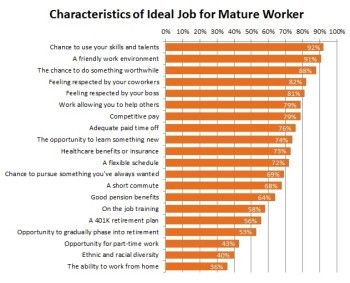Staffing trend watchers agree: the labor pool is shrinking overall. This is a global phenomenon, and it is happening across all sectors. Labor shortages are projected as Baby Boomers retire. There are simply not enough college graduates available to enter the workforce to replace retirees. Lance Jensen Richards and Jason S. Morga summarize the problem: “With the overall workforce aging, birth rates in mature markets dropping, labor pools in developed nations shrinking, the numbers of skilled workers dropping, and the demand for skilled workers accelerating along with technology evolution — the global workforce could soon be in a world of trouble.”
Companies that recruit only from age-homogeneous talent pools may not only miss talent but find that their recruiting costs are higher. CareerBuilder’s Tim Sackett admonishes: “when you have a ‘non-official’ policy of hiring young and aggressive — and you think you are getting the best talent — you are getting the watered-down talent that has been picked through by everyone else.” Paula Norbom, President of Talencio, LLC agrees: “We simply can’t continue to believe that a new crop of college graduates or MBAs will come to the talent rescue – the demographics will not support it and it’s not a sustainable practice.”
Instead, Norbom suggests that companies engage in outside-the-box thinking by considering experienced talent – those who are retirement age – to find people who are capable and available to fill talent gaps. The Pew Research Center predicts that mature workers (those who are retirement age but still interested in working) will fuel 93% of the growth in the U.S. labor market through 2016. Today’s older generation is more active and fit than ever before, and many are interested in continuing to pursue work interests.
In a survey published in 2013 by AARP of experienced workers (ages 45-75), 70% indicated they planned to work during retirement. More than half (52%) expect to work part time, with 29% of those expecting to work part-time primarily for enjoyment and 23% expecting to work part-time primarily for the income. Thirteen percent expect to work in retirement by starting a new business or working for themselves, and 5% expect to work full-time in a new career.
On What Terms?
While it is true that older workers are interested in continuing to contribute to the world of work, Talencio’s Norbom cautions that “willingness to stay in the game does not mean continuing in the 40-hour work week mode.” Instead she suggests that these mature workers are looking for flexibility, interesting work, fair compensation and the opportunity to continue to make a difference while maintaining a healthy work-life balance. They still want to contribute and feel that sense of accomplishment that only comes from a job well done. Most are seeking flexibility – the flexibility to work part-time, remotely, or on a project by project basis, with time in-between to travel, spend with family and pursue hobbies. Technology can facilitate telecommuting and involvement from a remote location. But companies will need to re-think their terms of engagement to attract this mature, seasoned talent.
From AARP 2013 Work and Career Study
To learn more about how other Life Science companies have partnered with us to overcome hurdles and capacity issues, and tapped into our skilled professional talent pool, contact me at 612.703.4236 or email me at: pnorbom@talencio.com. Talencio, LLC has been the preferred provider of vetted, accomplished professionals to the Life Sciences community for more than seven years.
Sources:
The Aging Workforce: Leveraging the Talents of Mature Employees. SHRM Foundation, 2014
Career Builders, Tim Sackett, Admit It: You Discriminate Against Older Workers, November 12, 2014
Lisa McQuery, Demand Media. The advantage of diverse ages in the workplace
Six global trends shaping the business world: Demographic shifts transform the global workforce. Ernst & Young Global Limited
Staying Ahead of the Curve 2013: The AARP Work and Career Study
U.S. Bureau of Labor Statistics. Labor force projections to 2020: a more slowly growing workforce. Monthly Labor Review, January 2012, 43-64
